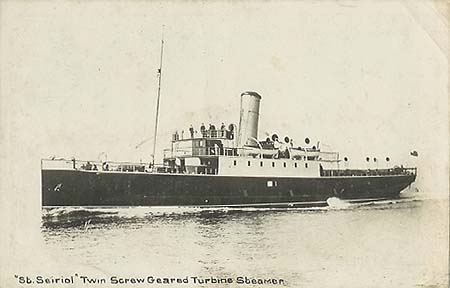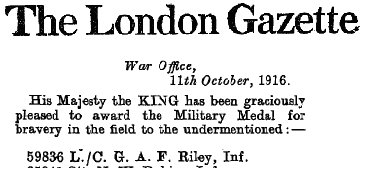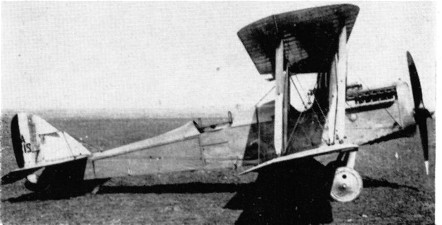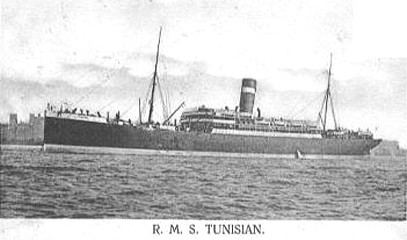|
Aug 6, 1893
|
Born at Trenton
Ontario
|
|
Oct 22, 1914
|
Shown on payroll
of the 49th Regiment, Hastings Rifles
|
|
Nov 5, 1914
|
Attested into
the 21st Battalion at Kingston Ontario
Ø Number 59836 (temporary number 221)
Ø Next of kin given as George Henry Riley (father) of Trenton Ontario
Ø Previous occupation given as Farmer
Ø No previous military experience given
Ø Religion given as Church of England
|
|
May 6, 1915
|
Embarked the RMS
Metagama at Montreal Quebec

|
|
May 15, 1915
|
Disembarked at
Devonport England and proceeded to West Sandling Camp, near Hythe, Kent
|
|
Sep 14, 1915
|
Embarked the St
Seiriol at Folkestone

|
|
Sep 14, 1915
|
Disembarked at
Boulogne France and proceeded to St Omer
|
|
May 3, 1916
|
Appointed to
rank of Lance Cpl with pay
|
|
May 15, 1916
|
Granted 9 days
leave
|
|
May 23, 1916
|
Granted 1 day
extension to leave
|
|
May 24, 1916
|
At duty from
leave
|
|
Aug 12, 1916
|
Admitted to No 4
CFA (Canadian Field Ambulance) then transferred same day to No 6 CFA
|
|
Aug 15, 1916
|
Transferred to
No 2 DRS (Divisional Rest Station) at No 5 CFA, diagnosis reads PUO (Pyrexia of Unknown
Origin) which is a fever, more commonly called Trench Fever
This
diagnosis was then changed to read Influenza
|
|
Aug 20, 1916
|
Discharged from
No 2 DRS and rejoined the 21st Battalion
|
|
Oct 8, 1916
|
Promoted to rank
of Cpl to replace Cpl RA Ford, 59332, who was wounded
|
|
Oct 11, 1916
|
Awarded the
Military Medal per London Gazette #29780


|
|
May 12, 1917
|
Proceeded to
England and reported to EORD at Seaford with a view to obtaining a commission
|
|
Jun 11, 1917
|
Attached to 10th
Canadian Stationary Hospital at Eastbourne for duty
|
|
Jul 3, 1917
|
Ceases to be
attached to 10th CS Hosp and returned to EORD
|
|
Jul 7, 1917
|
On Command to
OTC (Officer Training Course) at Bexhill
|
|
Sep 1, 1917
|
Received his
Commission and reported to 6th Reserve Battalion as a Temporary Lieutenant
|
|
Nov 21, 1917
|
Posted to the 21st
Battalion
|
|
Nov 22, 1917
|
Arrived at No 2
CIBD (Canadian Infantry Base Depot) at Havre France, and TOS 21st Battalion
|
|
Nov 26, 1917
|
Left CIBD to
join unit
|
|
Nov 28, 1917
|
Rejoined the 21st
Battalion in the field and assigned to the Battalion Headquarters
The Battalion was in the Support
Trenches in Vancouver Road area
|
|
Jan 24, 1918
|
Proceeded on
Course
|
|
Jan 30, 1918
|
Rejoined from
course
|
|
May 21, 1918
|
Attached to the
RAF (Royal Air Force) as an Air Observer on probation and proceeded to England via
Boulogne
|
|
Aug 21, 1918
|
Posted to EORD
|
|
Aug 22, 1918
|
On Command to
RAF for training as an Observer
|
|
Aug 29, 1918
|
Granted
Temporary Commission as 2nd Lieutenant, Observer and to be Honourary Lieutenant
|
|
Sep 1, 1918
|
Returned to
France and attached to # 57 Squadron, RAF

He would have been flying in a DH4
No. 57 Squadron, RFC, was formed at Copmanthorpe, near
York, on 8th June, 1916, from a nucleus flight provided by No. 33 Home Defence Squadron
and in December of the same year crossed to France as a fighter-reconnaissance unit
equipped with FE2d's. In May 1917, the squadron began to convert to Rolls-Royce
Eagle-engined DH4s and in June, on completion of its conversion training, moved up into
the Ypres sector and started long-distance reconnaissance, bombing and photography. In
July oxygen-breathing apparatus and negative-lens bombsights were fitted to all aircraft
and thereafter both bombing and photography improved. In all its work No. 57 met strong
opposition from enemy fighters and many successful combats were fought.
The squadron continued photographic reconnaissances and
bombing raids on targets behind the enemy's lines, and although it suffered heavy
casualties during the summer and autumn of 1918 -its record of achievement was high.
During its service in France No. 57 Squadron destroyed 166 enemy aircraft, dropped 285
tons of bombs, exposed 22,030 photographic plates and made 196 successful reconnaissances.
|
|
Sep 5, 1918
|
Admitted to No 6
Stationary Hospital at Frevent with a gun shot wound to left arm. Wound was described as “slight”
It is quite possible that this was
his first mission. If it wasn’t his
first, it would have been one of the first as he was only in France with the Squadron for
4 days.
|
|
Sep 6, 1918
|
Transferred to
No 8 General Hospital at Rouen
|
|
Sep 8, 1918
|
Invalided to
England aboard the Hospital Ship Aberdonian

TOS EORD
while in hospital but remains attached to the RAF
|
|
Sep 9, 1918
|
Transferred to
Lady Cooper’s Hospital, Hursley Park, Winchester
|
|
Sep 28, 1918
|
Discharged from
hospital and granted 3 weeks sick leave
|
|
Nov 2, 1918
|
Next of kin
changed to read Mrs Constance Riley (wife) of 133 Lilford Road, Camberwell, London
|
|
Mar 24, 1919
|
Ceases to be
attached to RAF and relinquishes Commission as 2nd Lieut in the RAF and assumes
the rank of Lieut in the CEF
|
|
Mar 31, 1919
|
TOS 6th
Reserve Battalion at Seaford
|
|
Apr 14, 1919
|
Posted to No 3
Regimental Depot
|
|
Jun 14, 1919
|
TOS EORD and
shown on leave
|
|
Jul 5, 1919
|
Embarked the RMS
Tunisian at Liverpool

TOS MD #5 in
Canada
|
|
Jul 14, 1919
|
Disembarked at
Montreal Quebec Canada
|
|
Jul 15, 1919
|
Discharged from
the CEF
Proposed residence on discharge
– RR #3, Trenton Ontario
Rank on discharge - Lieutenant
|
|
Oct 17, 1929
|
British War
Medal and Victory Medal sent to Trenton Ontario by the British Air Ministry
|
|

